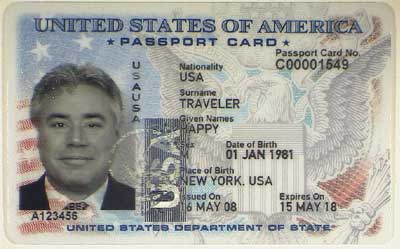“May We See Your Papers?”: Passport Cards and Trusted Travelers
Growing up in Buffalo, Paper Doll cheerfully recalls taking jaunts across the U.S.-Canadian border on a whim. When visitors wanted to see Niagara Falls, or if we had a craving for Chinese food in Fort Erie, Ontario, or we just had a hankering for the best candy bar ever invented 

we needed only to gas up the car and head over the Peace Bridge.
Traveling is more complicated these days. As a result of the Intelligence Reform and Terrorism Prevention Act of 2004 (IRTPA), the Western Hemisphere Travel Initiative (WHTI) began requiring that all American and Canadian travelers present passports or other citizenship/identification documents when entering the United States. In theory, the WHTI is supposed to strengthen border security by allowing the Department of Homeland Security to reliably identify all travelers while facilitating entry for U.S. citizens and legitimate foreign visitors.
However, once the WHTI went into effect on June 1, 2009 (for land and sea travel — for air travel, it had already been active in 2007), life changed dramatically for those living along the borders. While it had often been a slow and complex task to cross back into the United States from Mexico, Americans recall fondly their ability to spend summer afternoons in Canada and cross home without effort.
In the past, we’ve discussed how to get, renew and replace a passport, one of the truly vital VIPs (Very Important Papers) at our disposal. But there are actually some other incredibly useful documents that work as alternatives to, or in addition to, the U.S. passport.
PASSPORT CARDS

Passport cards, which have been in existence since July 2008, are similar in many ways to traditional passport books, but are less expensive and smaller (and therefore, more convenient); however, their use for travel purposes is more limited.
Passport books are valid for all international travel — by air, sea or land — and are good for 10 years (for adults, or five years for minors under 16). They measure 5″ x 3 1/3″ when closed, and currently cost $100 ($75 plus a $25 application fee) — new — or $75 to replace.
By comparison, the new passport cards are valid only when entering the United States
from Canada, Mexico, the Caribbean and Bermuda, and are valid only at land border crossings or sea ports-of-entry. You cannot use a passport card for international travel by air. The cards are wallet-sized, similar to credit or library cards. New cards cost only $45 ($20 plus the $25 application fee) and cost $20 to renew.
Adults who already have a passport book that’s been renewed within the last 15 years can get a passport card for a teeny $20 (and no application fee). If you jointly apply for a first-time passport book and passport card, you’ll save $25 and pay a single application fee.
Like the new passport books, passport cards have vicinity-read radio frequency identification (RFID) chips embedded within them to prevent forgeries, and application times run the same as for passport books.
Wouldn’t it would be nice if you were visiting friends in Washington State or Michigan or New York State and someone suggested a quick day trip to Vancouver or Windsor or Niagara Falls, if you could jump into the car and go? After all, few of us travel domestically with our passports. If you live anywhere close to the Canadian or Mexican borders, or are far more likely to visit border communities than travel abroad, a passport card makes spontaneous wanderlust a little more convenient.
If you don’t already have a passport book or card, you can apply for just the passport card at any of the 9400 passport acceptance facilities. (It’s likely that your nearest post office is on the list.) You’ll need all the same documentation you’d provide if applying for a passport, and will have to fill out a DS-11 form.
If you already have a passport book and just need a passport card, or wish to renew your passport while acquiring a passport card, you’ll want form DS-82 — fill out the online version or print out the application to mail with your documentation.
TRUSTED TRAVELER PROGRAMS
The Department of Homeland Security’s U.S. Customs and Border Patrol (CBP) has created special cards, separate from the passport card, as part of the new Trusted Traveler Programs. These card programs include NEXUS and SENTRI.
Applicants have to submit to a thorough background check, fingerprinting (inky!) and an in-person interview, but the cards help you access dedicated commuter lanes and skip past the long customs lines. So, a little inconvenience and cost up front will free up hours of standing in line over the course the coming years. This is great for frequent business travelers, people who live on one side of the border but work on the other side, and divorced parents attempting to make cross-border weekend custody hand-offs no more stressful than the ubiquitous McDonald’s playground exchanges.
NEXUS

NEXUS is a joint U.S.-Canadian program that was designed to enable “low-risk”, pre-approved travelers to cross the border quickly–via air, sea or land. Whether you travel for business or pleasure, as a member of the NEXUS program, you’re allowed to skip long border entry points by using self-serve computerized airport kiosks (similar to the kiosks you’ve probably already used for checking in). There are also special NEXUS reserved lanes at land (drive-across) border crossings. For members crossing by boat, there’s a special phone system to make contact with border officials.
If you frequently cross the U.S.-Canadian border, you’ll still need to have a passport (book or card), but a NEXUS card, available for just $50 (once you apply and are approved) will speed your travels and make it much easier for you to get back to business (or fun) without waiting in long lines or idling in traffic lanes. (The $50 fee is waived for applicants under 18.)
To qualify for NEXUS, you must be an American citizen or a permanent resident of either Canada or the United States, and you must have lived continuously in either the U.S. or Canada for at least the past three years. For applicants under 18, both parents must grant written consent.
Obviously, to be approved, you must be legally admissible to both the U.S. and Canada (having complied with all the immigration and customs rules during prior travel), and you can’t have a single conviction on your record. (So, if you were convicted for trespass for protesting Apartheid in the 1980’s or were caught streaking in the 1970’s, there will be no speedy U.S.-Canadian travel for you!) After passing the initial investigation, applicants are interviewed in person and documents proving identity and admissibility are physically verified. Finally, if approved, applicants submit to being photographed, fingerprinted and, if they wish to use the NEXUS card for air travel, have their irises scanned. Whew.
Once approved, NEXUS member cards are valid for five years from the birthday following issuance. You have to start the renewal process about six months prior to expiration, which requires another interview to ascertain that you still qualify. (Yep, your streaking days are over!)
Submit applications (in English or French) online via the Global Online Enrollment System (GOES) or begin your enrollment in person at any of 24 enrollment centers in the U.S. or Canada, mainly at airports, sea ports and bridges. Although online applications are preferable, you may also print out the application.
Once you set up an account, GOES allows registered users to apply for any of the Trusted Traveler Programs. The CBP processes payment and certifies the application, and if membership is conditionally approved, the GOES account gets updated with instructions for scheduling an appointment for a NEXUS interview. (Note: every member of a household, children included, must have his or her own GOES account.) If everything goes according to plan, your NEXUS card will be mailed to you. To activate the card, you’ll go back to the GOES page to enter data from the card and verify receipt.
SENTRI

Like the NEXUS card, a Secure Electronic Network for Travelers Rapid Inspection, or SENTRI, card will speed your travels, and may be the right choice for you if you’re a frequent traveler between the U.S. and Mexico. SENTRI is pricier then NEXUS — the SENTRI card costs about $122.25, but generally operates in the same manner.
However, unlike NEXUS, SENTRI can only be used for arriving in the U.S. via land and sea; it can’t be used for speeding access to air travel. That’s because, unlike NEXUS, which is jointly operated by the CBP and the Canada Border Services Agency, only the CBP oversees SENTRI–Mexican authorities do not participate in oversight.
To apply for the SENTRI program, set up an account (as described in the NEXUS section) with GOES and apply in English or Spanish. You can also fill out a Form 823S and submit it at any of the SENTRI enrollment centers in Arizona, California, and Texas.
Remember, you still have to carry your actual passport when traveling internationally; the NEXUS and SENTRI cards merely speed the process.
Organized travel begins with organized paperwork. It makes sense to apply for passports and passport cards even before you have travel destinations in mind, so that if you ever win an all-expense paid trip to Montreal or Vancouver, Guadalajara or Puerto Vallarta, you’ll be ready. And, if your life makes you a frequent traveler to our nearest neighbors, consider whether your time is worth a little investment and investigation.
Happy traveling!




Follow Me